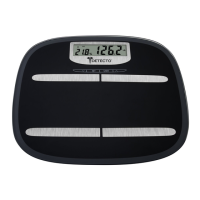13
2. How is percentage body fat (%BF) estimated?
The percentage of BF is measured by a method called Bioelectrical Impedance Analysis
(BIA). The use of BIA to estimate body fat has been pioneered since the seventies. It was only
in the past decade that the estimation of body fat using BIA technology was successfully
offered to the consumer as a compact bathroom scale. With BIA technology, a low intensity
electrical signal is sent through the body. The signal is very low and causes no bodily harm.
Depending on the amount of body fat of the individual, the electrical signal will flow with
a different degree of difficulty. The difficulty with which a signal flows through the body is
called electrical impedance. Hence, by measuring the electrical impedance and applying
to the data a proprietary algorithm, %BF can be estimated. Please note that the percentage
of body fat and body water will not add up to 100%.
Please be reminded that the %BF estimated with the scale represents only a good
approximation of your actual body fat. There exist clinical methods of estimating
body fat that can be ordered by your physician.
3. What is Bone Mass?
Our Body Fat Scale estimates the weight of non-living bone mineral content. This is important
for monitoring and maintaining healthy bones through exercise and calcium-rich diet. An
adult skeleton is made up of 206 bones, which come in several different shapes and sizes
and have specific structure. Your bones contain blood vessels, nerve cells and living bone
cells known as osteocytes. These are held together by a framework of hard, non-living
material containing calcium and phosphorous. A thin membrane called the periosteum
covers the surface of your bones.
Bone Mineral Content differs according to age and sex.
The typical range of percentage bone mass (mineral content) of average men and
women is between 4.0 to 5.3%. (Rico 1993)
4. What is Body Mass Index (BMI)?
BMI is a ratio of a person’s weight to height. BMI is commonly used to classify weight as
“healthy” or “unhealthy”.
5. Why is it important to monitor percentage Total Body Water (%TBW) in the body?
Water is an essential component of the body and its level is one of the health indicators. Water
makes up approximately between 50-70% of the body's weight. It is present proportionally more
in lean tissue compared to fat tissue. Water is a medium for biochemical reactions that regulate
body functions. Waste products are carried in water from cells for excretion in urine and sweat.
Water provides form to cells; helps to maintain body temperature; provides moisture to skin and
mucosa; cushions vital organs; lubricates joints and is a component of many body fluids. The
amount of water in the body fluctuates with the hydration level of the body and state of health.
Monitoring the level of body water can be a useful tool for one's health maintenance. Similar to
body fat estimation, the %TBW function provided in this scale is based on BIA.
BMI
30 and over Obese
25 – 29.9 Overweight
18.5 – 24.9 Normal
Under 18.5 Underweight
(BMI for adult 19-99 of age)

